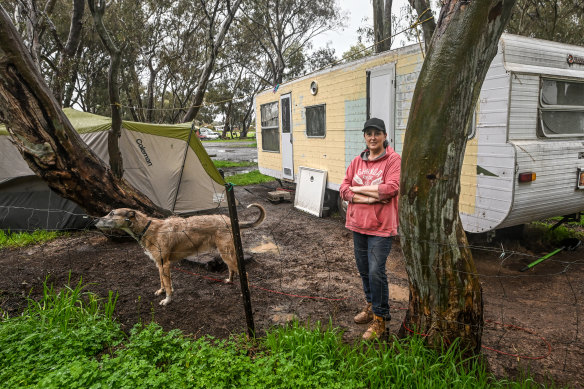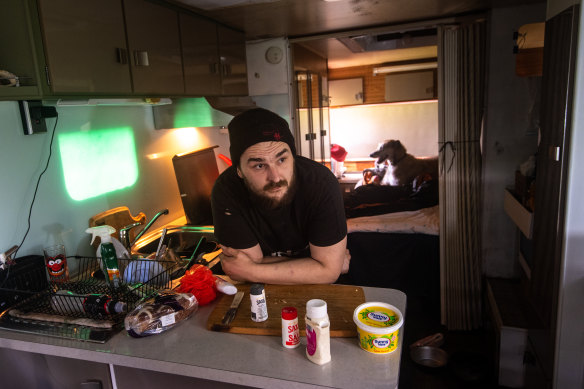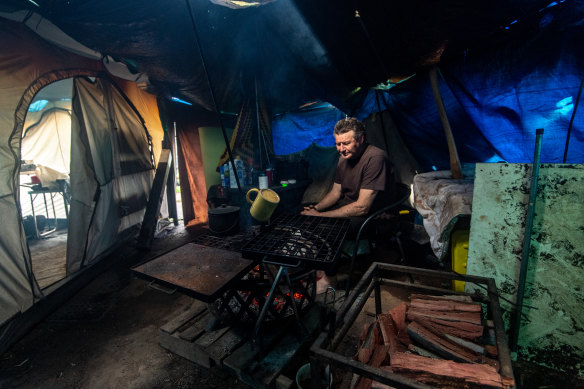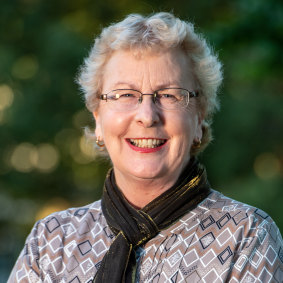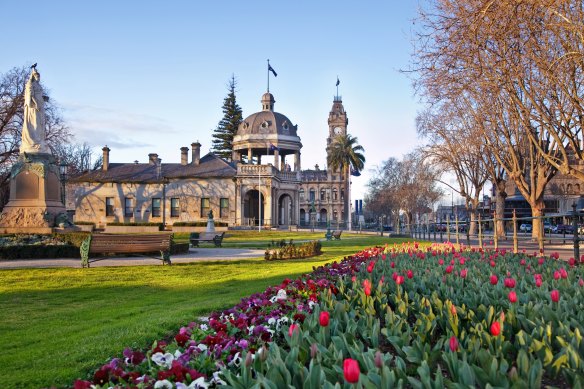Key points
- Workers in regional Victoria who could afford to pay rent cannot find accommodation as competition grows for scarce rental properties.
- Rents have risen across regional Victoria and the rental vacancy rate is low in several regional cities.
Workers in regional Victorian towns are being forced to sleep in tents, cars or caravans after a tree-change exodus from Melbourne over the past two years increased competition for rental properties to crisis levels.
The rental vacancy rate is below 1 per cent in every regional area in the state except one, Domain data shows, and the demand has increased rents in every council area outside Melbourne bar one over the past year.
Leanne Gray had to leave her rental home when the owners wanted to use it to house family.Credit:Justin McManus
The shortage of rental accommodation is driving key workers including hospitality staff, those in caring professions, or in service roles, and who could afford rent if they could find a long-term residence, to stay in campsites.
Homelessness services are also being overwhelmed as the number of available and affordable rentals dwindles, the National Homelessness Conference in Canberra was told this week.
Leanne Gray worked in customer service for 35 years, but when she was evicted from her rental home six months ago because the owners wanted to use it for their family, her only option was to move into a campground in Bendigo. She started off in a tent, and considers herself lucky to have a caravan which she shares with 25-year-old son Jake and Irish wolfhound Tiggy.
“We don’t have power here, we can’t shower,” Gray said. “It’s freezing here and we’re living in a tin can.”
Leanne Gray’s son, Jake, in their caravan with dog Tiggy.Credit:Justin McManus
The 53-year-old said there were not enough available rental properties in Bendigo to meet demand and now, without a fixed address, she and her son were unable to find work.
Her tent she once used is inhabited by Tim Ferrari, 55, who has been living at the campground for the past 2½ months. He had been doing labouring work, but needed to take a break. He was left without a home when his relationship broke down, then moved in with his stepfather and was told he could not stay.
He looked for a rental property, but the homes on offer drew anywhere from 50 to 150 applications.
“I went through about 30 properties before it sunk in, ‘well, this is not happening’,” he said.
Tim Ferrari has been living in a tent after facing tough competition for rental properties.Credit:Justin McManus
Trudi Ray, deputy chief executive of Haven Home Safe, a homelessness organisation that provides housing solutions in Geelong and Bendigo, said about 25 key workers were sleeping rough in a campground in Bendigo’s north due to lack of affordable housing.
“It’s a Bendigo outrage how these people don’t have anywhere to stay,” Ray said during her presentation at the conference run by the Australian Housing and Urban Research Institute and Homelessness Australia.
Some are itinerant workers picking fruit, while others had full-time jobs in Bendigo. They did not consider themselves homeless because they either worked, or had job prospects, but were simply unable to find a house.
“They’re not our clients because they think they’re OK,” she said. “They just can’t find a rental.”
The rental vacancy rate in central Bendigo is a wafer-thin 0.9 per cent, Domain data shows. Greater Bendigo rents rose 10.5 per cent over the past year to a median $420 per week.
Tenants who try looking further afield may have no more luck, as the vacancy rate is just 0.5 per cent in the nearby region of Heathcote-Castlemaine-Kyneton, and in Loddon-Elmore it is 0.2 per cent.
The issue is widespread in regional Victoria. Geelong rents are 5.9 per cent more expensive than a year ago and the vacancy rate in central Geelong is 0.7 per cent. Ballarat’s vacancy rate is also at 0.7 per cent and rent has increased 5.6 per cent in a year.
Kevin Woodroffe is an itinerant worker who has been travelling between NSW and Victoria during the past few months. He has been sleeping in a car he inherited after his father died, and has been unable to find an affordable place to live.
“I don’t work [at the moment] and I can’t find a house,” Woodroffe said.
Bendigo City Council Mayor Andrea Metcalf said there had been high demand for rentals as new residents arrived from Melbourne, which was happening even before the pandemic, albeit at a slower rate.
Bendigo Mayor Andrea Metcalf.Credit:Bendigo Council
“It was starting to show the cracks, but I would think that the pandemic has exacerbated it more,” Metcalf said.
Melbourne lost 85,000 residents in 12 months during the depths of COVID-19 restrictions, Australian Bureau of Statistics data shows.
Council figures show that about 3000 people in Bendigo need housing and the area needs more affordable housing to attract skilled workers. The council introduced an Affordable Housing Action Plan in September last year, which will require developers to have inclusionary housing zones in every development.
Metcalf said adding more one- to two-bedroom homes to the mix would mean older people, single people and those moving out of home for the first time would have more choice, as would those who need affordable options.
“We can do things like the Affordable Housing Action Plan … but a lot of the fixes around affordable housing sit with the state and federal governments,” Metcalf said.
The state government’s Big Housing Build has promised $85 million to Bendigo.“We’ll be really pleased to see those houses being rolled out and people moving into them,” Metcalf said.
Ray said the Big Housing Build would offer 12,000 new and existing properties over the next four years, and there were additional housing promises from the federal government, but there would still be a shortage even when they were all built.
Ray said one in 30 young people aged 15 to 19 had experienced first-time homelessness during the pandemic. The issue hit twice as many women and girls as men last year. About 5060 young people who presented to homelessness services in Victoria were unable to be housed due to a lack of supply, she said.
Meanwhile, homes across Victoria were being under-utilised, she said.
“We’re seeing a lot of homes that are full on the weekend – the ‘weekenders’ for city folk – but they are certainly vacant during the week,” Ray said.
Bendigo is not the only regional centre with a rental crisis.
In Yarriambiack Shire, which includes Warracknabeal, 680 homes are unoccupied.
Even someone looking for a temporary stay in a hotel may struggle. Booming tourism in the Bendigo area, while a boon for local businesses, had filled hotel rooms. The recent Elvis exhibition meant hotels were fully booked for four months, she said.
Companies in areas like the Wimmera had started providing housing for their workers, while others in areas like Castlemaine or Colac were providing transport to and from factories to overcome housing shortages.
Ballarat was also facing a rental squeeze, and the manager of homelessness services at church-based group Uniting Ballarat, Adam Liversage, said there were few rental homes available.
“We had a representative from a real estate agency [speak to us] who said they had 500 rentals in Ballarat and surrounds and only one property was available to rent,” Liversage said. “Warrnambool has a similar trend to Ballarat … where there’s only 151 properties available for rent.”
“We also provide over 3500 food vouchers. What we know is one in four families, regardless of their socioeconomic status, coming to us now are accepting food relief.”
The Money with Jess newsletter helps you budget, earn, invest and enjoy your money. Sign up to get it every Sunday.
Most Viewed in National
From our partners
Source: Read Full Article
